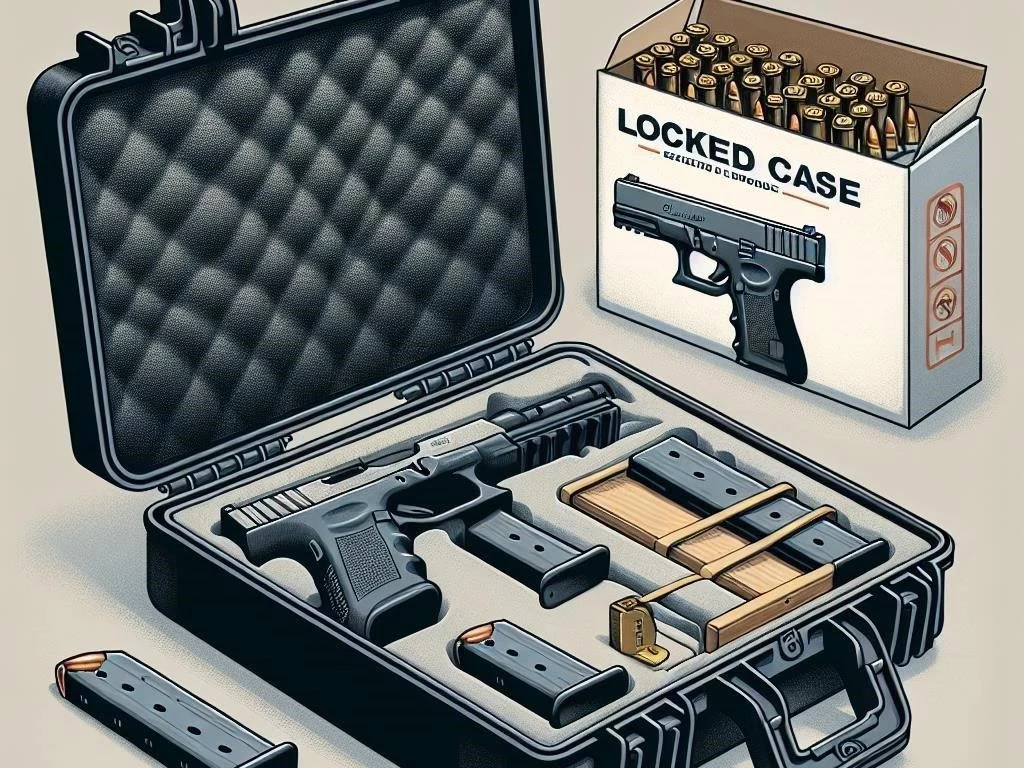What is the Recommended Way to Transport a Firearm
The recommended way to transport a firearm includes using secure cases, adhering to legal guidelines, and ensuring proper handling practices during travel and storage.
Transporting firearms safely is crucial for preventing accidents, ensuring legal compliance, and protecting ownership responsibilities. Awareness of laws enhances responsible firearm ownership and handling practices.
1.1 Importance of Safe Firearm Transportation
Safe firearm transportation is essential to prevent accidents and ensure public safety. Proper methods minimize risks to the owner, passengers, and the general public. Adhering to legal requirements and transport guidelines not only protects individuals but also upholds community trust. Incorporating secure storage practices, like using firearm cases, enhances safety during travel. Understanding state laws and federal regulations further supports responsible ownership and compliance. Responsible firearm transportation reflects an owner’s commitment to safety and legal standards. By prioritizing safety, firearm owners contribute to a culture of respect and awareness, ultimately promoting safer environments for everyone involved in the process of firearm ownership and transportation.
1.2 Overview of Firearm Ownership Responsibilities
Firearm ownership entails significant responsibilities, including understanding legal obligations, promoting safety, and ensuring secure storage. Owners must be aware of state laws and federal regulations that govern firearm transportation and usage. It is crucial to practice safe handling methods, such as using secure locking mechanisms and appropriate firearm cases. Additionally, owners should educate themselves about ammunition handling and transport guidelines to minimize risks. Respecting public transportation regulations and compliance with travel regulations is vital for responsible firearm ownership. Ultimately, firearm owners are accountable for their actions and must prioritize safety, legality, and ethical considerations when transporting and storing their firearms.
Understanding Legal Requirements
Understanding legal requirements for firearm transportation is essential. Compliance with federal regulations and state laws ensures safe and legal ownership, minimizing risks associated with transportation.
2.1 Federal Regulations on Firearm Transportation
Federal regulations on firearm transportation primarily revolve around the Gun Control Act, which mandates safe and legal transport across state lines. Firearms must be unloaded and stored in a locked container, separate from ammunition. Compliance with the Bureau of Alcohol, Tobacco, Firearms and Explosives (ATF) guidelines is essential. Interstate travelers should also familiarize themselves with the specific laws of each state they pass through, as regulations may vary significantly. Additionally, individuals must ensure that their transportation methods adhere to airline policies if traveling by air. Understanding these federal regulations helps prevent legal complications and promotes responsible firearm ownership during travel.
2;2 State Laws Governing Firearm Transportation
State laws governing firearm transportation can vary widely, making it crucial for owners to understand local regulations. Many states require firearms to be unloaded and stored in a secure case during transport. Some states permit concealed carry, while others mandate open carry, with specific guidelines on both methods. Additionally, certain states have restrictions on transporting firearms in vehicles, requiring them to be locked and separate from ammunition. It is essential to research and comply with these laws to avoid legal repercussions. Firearm owners are encouraged to stay informed about their state’s laws and any changes that may affect transportation practices and responsibilities.
Transport Guidelines for Firearm Owners
Transport guidelines for firearm owners emphasize safety, legal compliance, and secure storage. Following these practices ensures responsible ownership and minimizes risks during firearm transportation.
3.1 General Transport Guidelines
When transporting a firearm, ensure it is unloaded and stored in a secure locking case to prevent unauthorized access. Keep ammunition stored separately and in a secure manner. Familiarize yourself with both federal and state regulations governing firearm transport to remain compliant. Always transport firearms in the trunk of your vehicle, if possible, to enhance security and minimize visibility. Avoid displaying firearms in public spaces, and be aware of local laws regarding carrying methods. Prioritize safe handling practices throughout the transportation process, and educate others who may travel with you about proper firearm safety to promote a responsible ownership culture.
3.2 Specific Transport Guidelines for Different Firearm Types
Transporting firearms requires specific guidelines depending on the type. For handguns, utilize a secure case or holster, ensuring they are unloaded. For rifles and shotguns, transport them in a locked, hard-sided case, with the action open when possible. Always remove detachable magazines and store them separately. For specialty firearms, such as antique or collectible pieces, consider using padded cases to prevent damage during transport. When traveling for hunting, ensure compliance with hunting laws, including proper tagging and licensing. Understanding the nuances of transporting different firearm types enhances safety and legal compliance, ensuring responsible ownership throughout the transportation process.
Carrying Methods for Firearms
Understanding carrying methods for firearms is essential for responsible ownership. Different methods, such as concealed and open carry, have specific legal and safety considerations.
4.1 Concealed Carry: Rules and Best Practices
Concealed carry requires strict adherence to laws and best practices to ensure safety and legality. First, obtain the necessary permits as required by state laws. Always carry the firearm in a secure holster, ensuring it is properly fitted to your body and firearm type. Be mindful of your surroundings and avoid drawing attention to your concealed weapon. Regularly practice safe handling techniques, including safe draws and reholstering, to enhance proficiency. Additionally, ensure your firearm is regularly maintained and in good condition. Educating yourself about local regulations and engaging in ongoing training can greatly improve your skills and confidence while practicing concealed carry responsibly.
4.2 Open Carry: Rules and Best Practices
Open carry involves specific rules and best practices to ensure safety and compliance with legal standards. First, verify that open carry is permitted in your state, as laws vary significantly. When open carrying, utilize a secure holster that allows for safe access while preventing accidental discharge. Be aware of your surroundings and maintain a calm demeanor, as open carry may attract attention. It’s crucial to practice safe handling techniques, including drawing and reholstering your firearm, to ensure proficiency. Regular training and education about local laws and community expectations enhance responsible open carry practices, fostering a culture of respect and safety among firearm owners.
Vehicle Transportation of Firearms
Vehicle transportation of firearms requires adherence to legal guidelines, ensuring secure storage, and following safe handling practices to promote responsible ownership during travel.
5.1 Legal Considerations for Vehicle Transportation
When transporting firearms in a vehicle, understanding legal considerations is paramount to ensure compliance and safety. Many states require firearms to be unloaded and stored in a locked case, separate from ammunition. Additionally, familiarize yourself with local laws regarding the transport of firearms in vehicles, as regulations can differ significantly between jurisdictions. Some states may have specific requirements for carrying firearms in the passenger compartment or trunk. Always avoid displaying firearms to minimize risk and maintain discretion. If traveling across state lines, research the laws of each state you’ll pass through to ensure full compliance with varying regulations on firearm transportation.
5.2 Safe Storage in Vehicles
Safe storage of firearms in vehicles is essential for preventing unauthorized access and ensuring compliance with legal requirements. Always store firearms unloaded and secured in a locked case or safe, ideally placed in the trunk or a hidden compartment. Avoid leaving firearms in plain sight, as this could lead to theft or unwanted attention. Consider using biometric or combination locks for added security. Additionally, keep ammunition stored separately in a secure location to further enhance safety. Regularly check your storage methods and equipment to ensure they remain effective. By prioritizing safe storage practices, firearm owners can significantly reduce risks associated with vehicle transportation.
Secure Storage of Firearms
Secure storage of firearms is crucial for preventing unauthorized access, ensuring safety, and complying with legal requirements. Proper methods protect both individuals and communities.
6.1 Importance of Secure Locking Mechanisms
Secure locking mechanisms are vital in firearm storage to prevent unauthorized access and ensure safety. By utilizing high-quality locks on safes, cabinets, and cases, firearm owners can significantly reduce the risk of theft and accidental discharges. Secure locking mechanisms provide peace of mind, knowing that firearms are protected from children, intruders, or unauthorized individuals. Additionally, many states have legal requirements for secure storage, making compliance essential for responsible ownership. Regularly inspecting and maintaining locking mechanisms ensures their effectiveness over time. Investing in robust locking systems reflects a commitment to safety and responsibility, ultimately contributing to a culture of respect surrounding firearm ownership and usage.
6.2 Recommended Firearm Cases for Secure Storage
When selecting firearm cases for secure storage, prioritize durability and security features. Hard cases made from materials like polyethylene or aluminum provide excellent protection against impacts and environmental factors. Look for cases with secure locking mechanisms, such as combination locks or padlocks, to enhance safety. Additionally, consider padded cases that prevent movement and damage during transport. For handguns, compact cases with foam interior padding offer effective protection, while rifle cases should accommodate the firearm’s length and accessories. Waterproof cases are also beneficial for outdoor conditions. Investing in high-quality firearm cases reflects a commitment to responsible ownership and ensures the safety of stored firearms during transport.
Ammunition Handling and Transportation
Ammunition handling and transportation require strict adherence to safety practices and legal guidelines to ensure responsible ownership and minimize risks associated with firearm usage.
7.1 Legal Considerations for Ammunition Transport
When transporting ammunition, adherence to legal considerations is crucial for responsible firearm ownership. Many states have specific regulations regarding the transport of ammunition, including quantity limits and storage requirements. Typically, ammunition should be stored in a secure, labeled container, separate from firearms during transport. Familiarizing yourself with local laws helps avoid legal repercussions and ensures compliance. Additionally, federal regulations may apply, especially when traveling across state lines. Always check airline policies if flying, as they often have strict guidelines for transporting ammunition. Understanding these legal considerations promotes safety and responsibility, minimizing the risks associated with the transport of ammunition during any journey.
7.2 Safe Handling Practices for Ammunition
Safe handling practices for ammunition are essential to prevent accidents and ensure responsible ownership. Always treat ammunition as if it is live and potentially dangerous. Store ammunition in a cool, dry place, preferably in its original packaging or a designated container, to prevent degradation. When transporting ammunition, ensure it is securely packaged to avoid movement and damage. Avoid mixing different calibers in the same container to reduce confusion. Use gloves when handling ammunition to avoid contamination and ensure a secure grip. Lastly, familiarize yourself with the proper loading and unloading procedures for your firearm, as this promotes safety during ammunition handling and usage.
Public Transportation and Firearm Regulations
Understanding public transportation regulations for firearms is crucial. Owners must comply with legal requirements and safety practices to ensure responsible firearm transport in public settings.
8.1 Overview of Public Transportation Rules
Public transportation rules regarding firearms vary by jurisdiction and transport provider, making awareness essential for firearm owners. Many transit authorities prohibit firearms altogether, while others allow transportation under specific conditions. Typically, firearms must be unloaded and stored in a secure, locked case or container. Additionally, some regulations require ammunition to be stored separately from the firearm. Familiarize yourself with the policies of specific transit services, such as buses, trains, and airlines, as they may have unique guidelines. Always check local laws and regulations before traveling, ensuring compliance to avoid legal issues. Responsible ownership includes understanding and adhering to public transportation firearm rules.
8.2 Compliance with Public Transport Regulations
Compliance with public transport regulations is crucial for safe and legal firearm transportation. Start by thoroughly researching the policies of the transport provider you plan to use, as rules can vary significantly. Ensure that your firearm is unloaded and stored in a secure, locked case to meet safety requirements. Additionally, check if ammunition must be stored separately, as many regulations stipulate this practice. Always disclose your firearm if required by the transport authority, and be prepared to present necessary documentation, such as permits. Following these guidelines not only ensures compliance but also promotes a culture of responsibility among firearm owners in public spaces.
International Travel with Firearms
International travel with firearms involves complex legal requirements. Understanding regulations and documentation is essential for safe and compliant transportation across borders and jurisdictions.
9.1 Understanding International Travel Regulations
Understanding international travel regulations for firearms is essential for responsible ownership and legal compliance. Each country has specific laws governing the import and export of firearms, which may include permits, licenses, or registration requirements. Before traveling, research the regulations of your destination country, as some may prohibit certain types of firearms or ammunition altogether. Additionally, familiarize yourself with the regulations of the countries you’ll transit through, as they may have different rules. Always ensure that firearms are securely stored in a locked case and declared to customs officials upon arrival. Being well-informed and prepared can help you avoid legal issues while traveling internationally.
9.2 Documentation and Compliance for International Transport
Proper documentation and compliance are vital for the international transport of firearms. Begin by obtaining necessary permits or licenses from your home country, as many nations require proof of legal ownership. Research the specific documentation required by your destination country, which may include import permits or declarations. Additionally, ensure you have relevant travel documents, such as passports and visas, that comply with local regulations. When traveling, keep all documentation organized and accessible for customs inspections. Follow airline policies for transporting firearms, which often require firearms to be declared and stored in locked cases. Adhering to these guidelines minimizes legal complications during international travel.
Hunting Laws and Firearm Transportation
Hunting laws significantly influence firearm transportation practices. Understanding these regulations ensures compliance, promotes safety, and enhances responsible ownership during hunting activities and related travel.
10.1 State-Specific Hunting Laws
State-specific hunting laws dictate how firearms should be transported during hunting activities. These laws vary significantly, so understanding local regulations is crucial for compliance. Some states require firearms to be unloaded and encased during transport, while others may allow firearms to be carried in a ready-to-use condition. Additionally, specific deadlines for transporting firearms to and from hunting locations may apply. It’s essential to know the designated hunting seasons and any restrictions on certain types of firearms or ammunition. Always check for any required permits or licenses before heading out. Understanding these laws helps ensure responsible firearm ownership and enhances safety during your hunting experiences.
10.2 Transporting Firearms for Hunting Purposes
Transporting firearms for hunting purposes requires careful planning and compliance with legal requirements. Always ensure that firearms are unloaded and stored in a secure, locked case while in transit. This practice not only follows legal guidelines but also enhances safety. When traveling to hunting locations, be aware of state-specific regulations regarding loaded firearms, as some states prohibit carrying loaded guns in vehicles; Additionally, keep ammunition stored separately from firearms to further ensure safety. Familiarize yourself with the hunting area’s laws, including designated access routes and any required permits. Responsible transport practices demonstrate respect for wildlife and help maintain a safe hunting environment.
Proper firearm transportation methods ensure safety, compliance, and responsible ownership. Understanding regulations and best practices is essential for protecting yourself and others during travel.
11.1 Summary of Key Points
11.2 Final Recommendations for Safe Firearm Transportation
When transporting firearms, prioritize safety and compliance with legal regulations. Always store firearms in secure, locked cases to prevent unauthorized access. Ensure that firearms are unloaded during transport and that ammunition is stored separately. Familiarize yourself with both state and federal laws, as regulations can differ significantly. When using public transportation, adhere to the specific rules set by transport providers to avoid legal issues. For international travel, ensure you have all necessary documentation and permits. Additionally, conduct regular checks on your firearm storage methods to maintain security. Ultimately, responsible firearm transportation reflects a commitment to safety and respect for others in the community.














Post Comment